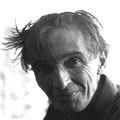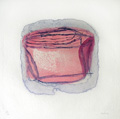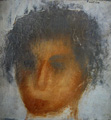Jean Fautrier
From Wikipedia, the free encyclopedia
Jean Fautrier (May 16, 1898–July 21, 1964) was a French painter and sculptor. He was one of the most important practitioners of Tachisme.
He was born in Paris and studied in London at the Royal Academy of Art and the Slade School. He first exhibited his paintings at the Salon d'Automne in 1922 and at the Fabre Gallery in 1923. In 1927, he painted a series of pictures (still lifes, nudes, landscapes) in which black dominates, and in 1928 he began work on a series of engravings for an illustrated edition of The Divine Comedy of Dante, prepared by Gallimard (which did not succeed). Until 1933 he divided his efforts between sculpture and painting; he then spent five years as a ski instructor in Savoy.
Fautrier resumed painting in 1937, and in 1943 made his twenty-second and last sculpture. The same year, stopped by the German gestapo, he fled Paris and found refuge in Châtenay-Malabry, where he began work on the project of the Otages. These paintings were exhibited in 1945 with the Drouin gallery. In the years that followed, Fautrier worked on the illustration of several works, among them Alleluiah by George Bataille, and made a series of paintings devoted to small familiar objects.
His late work is abstract, generally small in scale, often combining mixed media on paper. He died in Châtenay-Malabry in 1964. A retrospective was organized by the Gianadda Foundation with Martigny in January-March 2005.
Fautrier was born in Paris in 1898 and studied in London at the Royal Academy in 1912. After serving in the French army for three years (1917-20), Fautrier began his career as a painter. He had his first solo exhibition in 1924 at Galerie Visconti in Paris. In 1945, his Otages paintings were exhibited at the Galerie René Droun in Paris. After 1955, Fautrier's work was exhibited internationally on a regular basis. In 1960, he was awarded the International Grand Prize along with Hans Hartung at the XXX Venice Biennale. The following year, Fautrier won the Grand Prize at the 7th Tokyo Biennale. The Musée national d'art moderne de la ville de Paris mounted the first major retrospective of his work in 1964, the year of his death. Fautrier's work has subsequently been celebrated in Europe with numerous exhibitions including a major retrospective at the Musée d'art moderne de la ville de Paris in 1989.
Despite America's enthusiasm for French art from the early twentieth century on, Fautrier has gone largely overlooked in the United States except for a few exhibition appearances. His first appearance in an American exhibition was in 1930 in the exhibition Painting in Paris at the Museum of Modern Art in New York. His work was later exhibited in New York at the Iolas and Hugo Galleries in 1952 and 1956, and the Sidney Janis Gallery in 1957. American collectors who acquired his works included Duncan Phillips (1927), Walter Annenberg, William Jaffe, Barbara Rockefeller, Henry Luce, Helene Rubenstein, and the Menil family (1950s).
In the 1940s, Fautrier invented a new process of making paintings, replacing traditional oil and easel painting with haute pâte (high paste) constructions, represented in the exhibition by his Les Otages series. Fautrier, along with André Malraux, took part in the French resistance, and his Otage paintings represent a visual response to Nazi atrocities. Faturier's Originaux multiples of 1950 (hand painted lithographs) helped establish the groundwork for future debates in contemporary arts concerning the identity of a work of art by questioning the usual visual practices concerning original art works. These hybrid works represent an experiment intended to challenge the concepts of uniqueness with respect to original art works and to increase the audience for Fautrier's work.
This premiere exhibition will bring together over 60 works from public and private collections from Europe and the United States. Included in the exhibition will be paintings, works on paper, original multiples, and sculptures, as well as books illustrated by Fautrier. Featured works include a selection from his early period (1926-28), his Les Otages series (1945), and his late abstractions and objects (1955-1964). Institutional lenders include the Musée national d'art moderne, Paris; The Menil Collection, Houston; The Phillips Collection, Washington, D.C.; the Museum of Contemporary Art, Los Angeles; the Haggerty Museum of Art; and the Fogg Art Museum, Harvard University. Among the private lenders is Jacqueline Cousin, the last companion of the artist, who is expected to attend the exhibition opening.
The exhibition will open on September 19, 2002 with a lecture by Yve Alain Bois, Joseph Pulitzer, Jr. Professor of Modern Art, Harvard University, at 6 p.m. Bois' lecture will be followed by a reception at the Haggerty Museum of Art. French pianist Madeleine Malraux will present a concert in conjunction with the opening. Malraux, along with her late husband, the writer André Malraux, was active with the artist in the French Resistance during World War II.
The exhibition catalogue will be the first major Fautrier catalogue in English. It will contain new research on Fautrier in five scholarly essays by Benjamin Buchloh, Columbia University; Yve Alain Bois; Curtis Carter; Karen Butler, Columbia University; and Rachel Perry, Harvard University; new translations of critical writings by André Malraux, Jean Paulhan's Fautrier l'enragé and Francis Ponge's Notes sur les Otages, and previously unpublished letters from Fautrier's personal correspondence with the French critics André Malraux and Jean Paulhan, with color translations of the works in the exhibition.
It will be the first catalogue, in any language, to link Fautrier's post war work to its greater cultural context, showing his impact on contemporary artistic and literary movements in France and examining his work in light of the art of Jean Dubuffet and informel art in Europe, and concurrent post World War II developments in American Art, including Jackson Pollock and Abstract Expressionism. The catalogue, produced by the Haggerty Museum, the Fogg Art Museum and the Wallach Gallery, will be published by the Harvard University Art Museums and distributed by Yale University Press.
The Haggerty Museum of Art is located at North 13th St. and West Clybourn Avenue on the campus of Marquette University. Museum hours are Monday - Wednesday, Friday - Saturday, 10 am-4:30 p.m.; Thursday, 10 am-8 p.m.; and Sunday, noon-5 p.m.. Free parking is available in the Mary B. Finnigan Parking Lot (enter on 11th St. through Marquette Lot J). For more information on the exhibition or the Haggerty Museum, contact John Gardner at 414/288-3657.

After the early death of his father, Fautrier and his mother moved to London. At the tender age of 14, he already studied at the Royal Academy and later at the Slade School of Art. In early 1917 Fautrier returned to France to do his military service. In 1918 he suffered a gas poisoning at the front with life-long consequences. During a recovery trip to Tyrolia in 1920-21 Fautrier began to paint again. He produced expressive pictures of figures, portraits and still lives, whose brush stroke and almost caricature-like perception are reminiscent of Chaim Soutine. In 1925 and 1926 he produced unusual experimental compositions, in which the motif is hardly distinguishable between the rapidly applied color gestures and the monochrome color scheme. As early as 1923 he exhibited his pictures in Paris and from 1925 he had a contract with the renowned Paris gallery 'Guillaume'. After initial success with the sales of his work, Faultier increasingly withdrew from painting during the 1930s. In 1934 he left Paris to become a skiing instructor in Tignes and later sucessfully managed a hotel in Val d'Isère. At the beginning of World War II Fautrier left the Alps and returned to Paris via Marseille and Aix-en-Provence in 1940. The studio he set up for himself became a meeting-place for his friends who were active in the Résistance. After a temporary arrest Fautrier went into hiding in Dr. Lesavoureux's sanitorium, where he painted the series 'Otages' (hostage pictures) until 1945. These laid the foundation for Fautrier's later fame. From 1949 to 1954 his career as a painter was once more interrupted due to his difficult financial situation. The later French minister of culture and writer André Malraux, made Fautrier editor in the Gallimard publishing house, putting him in charge of the graphical side of art editions. Together with his wife Jeanine Aeply, Fautrier developed 'Originaux Multiples', a mixture of graphic print and painting, which they use in the distribution of this own work. In 1954 the artist began to paint in oil again, abandoning the haptic surfaces he had developed earlier. Exhibitions of this pictures followed throughout the world: among others at the dokumenta 2 in Kassel in 1959. In 1960 he received the Grand Prize at the Venice Biennale. Suffering from a serious illness, Fautrier was no longer able to attend the retrospective organized at the 'Musée d'Art Moderne de la Ville' in Paris in his honor in 1964. Fautrier died in Châtenay-Malabry on July 21, 1964.









Δεν υπάρχουν σχόλια:
Δημοσίευση σχολίου